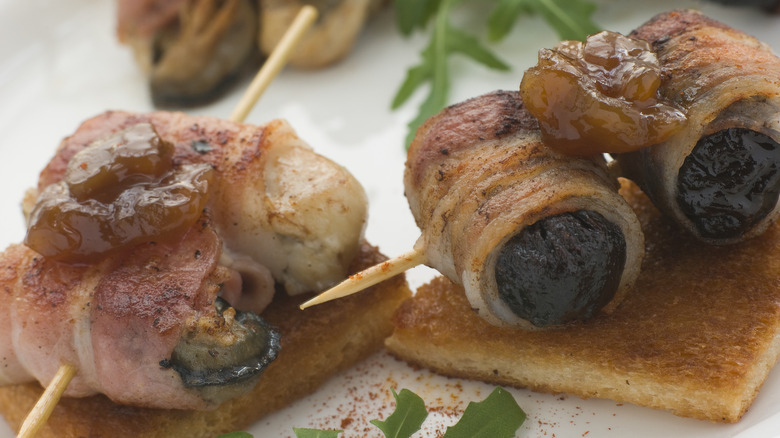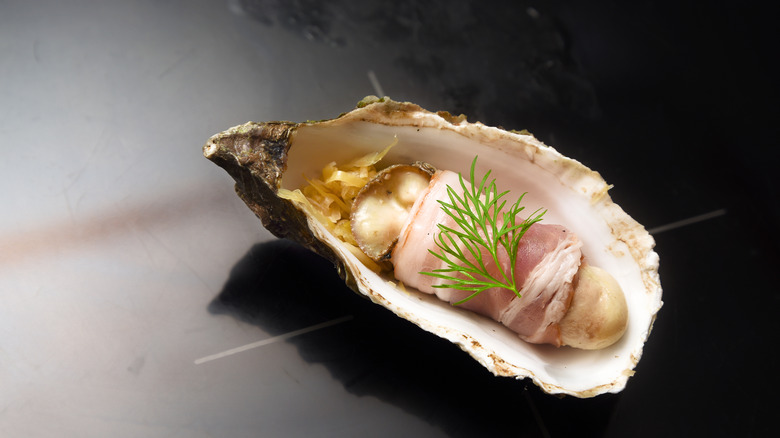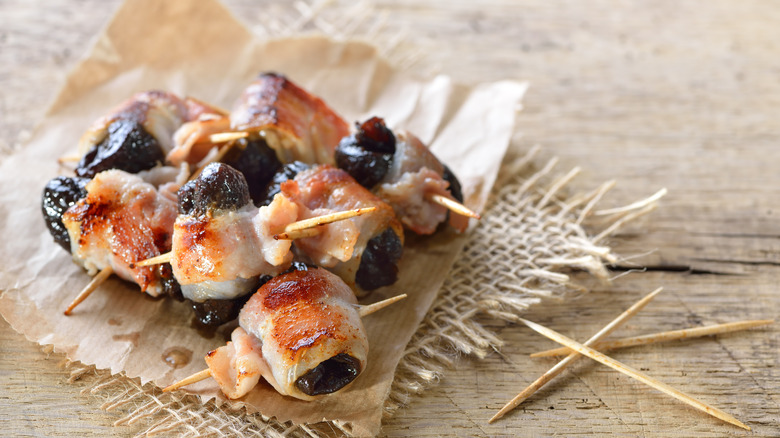Angels Vs. Devils On Horseback: What Makes These British Bites Different
If you were told that a party's menu would include "Angels on Horseback" and "Devils on Horseback," what would you picture? The names may conjure fun images of miniature knights or cowboys on your shoulder trying to guide a difficult decision, but they are, in fact, a set of complementary hors d'oeuvres made of an oyster or prune wrapped in bacon.
While the dishes are most associated with Victorian England, there is some dispute as to whether that is where they actually originated. Some say the recipes originated in England, while others support the theory that "Angels on Horseback" or "anges a cheval" were first created in France.
One thing that is agreed on is that the names of these dishes are a bit of a culinary mystery as there is nothing that seems inherently angelic, devilish, or horse-like about them. However, if we dig deeper, we can see what makes these savory and sweet bites delectably unique.
Angels on Horseback are oysters wrapped in bacon
Angels on Horseback were the original of the two "horseback" dishes and originated in the 19th century when oysters were considered cheap, lower-class food. The idea was to wrap the oysters in bacon, bake or fry them, and serve them on bread as an inexpensive dinner option. However, as the price of oysters increased in cities like London and New York, where they were once cheap and plentiful, Angels on Horseback graduated into the tier of upper-class dinner party appetizers.
British Food: A History notes that the best way to make these bite-sized delicacies is by purchasing large, pre-shucked oysters, wrapping them in bacon, and securing them with a toothpick before popping them in the oven. Recipes vary on whether the oysters should be baked, broiled, or fried, and some include serving them on toast, while others let them stand alone. Others recommend substituting less-expensive scallops for the oysters. While many recipes recommend serving the "angels" with a dash of lemon or lime juice, others suggest giving the angels a twist of heat by adding pepper or tabasco sauce, ironically making them a little more "hellish" than their devil counterparts.
With their continued popularity, which has ebbed and flowed through Europe and the U.S. over the decades, it seems the running consensus is that the name stems from the curled edges of the pinned bacon, creating angel-like wings.
Devils on Horseback are prunes wrapped in bacon
Sometime after the creation of Angels on Horseback, Devils on Horseback entered the scene. The name of these is somewhat easier to figure out as it was likely done as a play inspired by this dish's red and black coloring, and the original recipe called for cayenne pepper. But what makes it ironic is that most modern recipes do not include hot spices as many "deviled" foods often do. Instead, Devils on Horseback are made by taking pitted, large prunes and wrapping them in bacon, much like the oysters are wrapped in the angel recipe.
British Food: A History recommends first soaking the prunes in tea before stuffing them with almonds and wrapping them in bacon, using a toothpick to affix the meat once again. Other recipes recommend using soft cheese or chutney as a filling instead, though originally, no filling was required — just prunes and bacon. If you are not a prune fan, dates can also be substituted for prunes in this recipe, much like scallops work as an alternative to oysters. Serve them with their bacon-wrapped shellfish counterparts, and you have a sweet and savory appetizer combination made in Heaven (or Hell).


